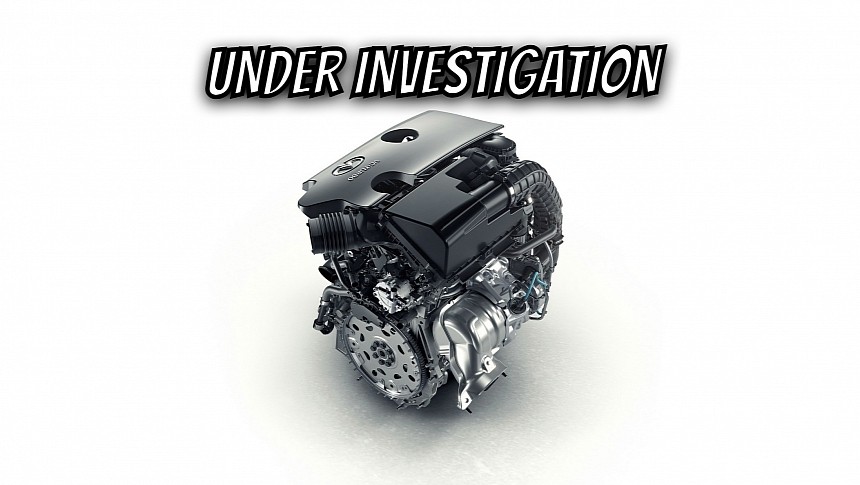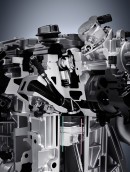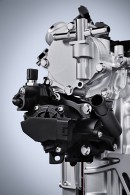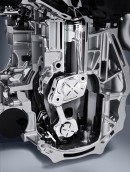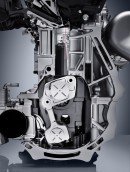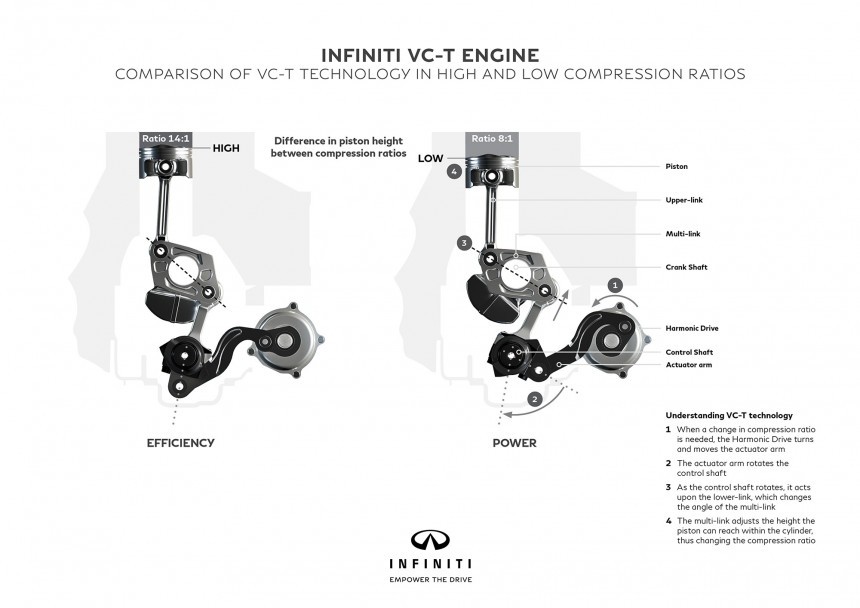Introduced in August 2016, the first of two variable-compression turbocharged engines developed by Nissan rolled out in series production one year later in the 2019 Infiniti QX50. The original engine is a 2.0-liter unit with four cylinders, a powerplant shared with the sixth generation of the Nissan Altima.
Internally referred to as the KR engine family, the VC-Turbo spawned a three-cylinder version for the Nissan Rogue, a.k.a. X-Trail outside of the United States. Also found in the Nissan Qashqai, the 1.5er is no slouch. Output numbers top 201 horsepower in the Rogue for North America and 243 pound-feet (330 Nm) in the Qashqai e-Power for EU markets.
Be that as it may, the VC-Turbo is a highly complex engine. Not only is it a bit stressed due to turbocharging, but the variable-compression bit adds unwanted complexity in the form of a multi-link mechanism that varies the piston's top dead center and bottom dead center positions. In other words, the compression ratio varies between 8:1 and 14:1 to give you better performance or better efficiency.
Not surprising in the least, said engine isn't exactly a stalwart of reliability. According to documents published by the National Highway Traffic Safety Administration, the Office of Defects Investigation has opened a preliminary evaluation into the Nissan VC-Turbo due to six owner questionnaires and multiple field reports alleging engine failures.
Both the KR20DDET and KR15DDT are under investigation. Based on the ODI's analysis of available data, Nissan has attempted to address main bearing and L-link concerns by introducing a number of manufacturing process changes since the KR20DDET rolled out in 2017. The main bearing allows the engine's crankshaft to rotate, whereas the L-link is an integral part of the variable-compression mechanism. Together with an actuator arm designed to rotate the control shaft, the Lower-link changes the multi-link system's angle, thus adjusting the vertical position of the piston stroke within the cylinder.
As mentioned earlier, too complex for what can only be described as unimpressive gains in performance and efficiency. Take, for instance, the 2.0-liter mill of the QX50 and QX55. The premium-oriented Infiniti brand quotes 268 horsepower, 280 pound-feet (380 Nm) of torque, and up to 26 miles per gallon (9.0 liters per 100 kilometers) on the combined test cycle. The Audi Q5, by comparison, belts out up to 261 horsepower and 273 pound-feet (370 Nm) from its 2.0-liter TSI four-pot while returning up to 26 mpg as well.
This preliminary evaluation aims to assess the scope, frequency, and the consequences of the VC-Turbo engine failures reported to the National Highway Traffic Safety Administration. The Office of Defects Investigation may further expand the scope of the subject vehicle population during the investigation, with the current estimate being 454,840 vehicles.
As per vehicle owner questionnaire 11526248, the owner of a 2023 Nissan Rogue experienced an unexpected engine stall on an off-ramp on an off-ramp. The vehicle in question had only 16,633 miles (26,768 kilometers) on the clock. The dealership determined that the engine had completely seized due to metal shavings, with said engine being replaced under warranty. The owner, however, notes that the cause for said metal shavings was never related to them by either the dealership or Nissan corporate.
According to vehicle owner questionnaire 11535791, which also concerns a 2023 model year Nissan Rogue with the 1.5-liter turbocharged engine, "Nissan is not telling the dealer the cause of the problem." Given these circumstances, fingers crossed the Office of Defects Investigation will eventually determine the root cause for these catastrophic engine failures.
Be that as it may, the VC-Turbo is a highly complex engine. Not only is it a bit stressed due to turbocharging, but the variable-compression bit adds unwanted complexity in the form of a multi-link mechanism that varies the piston's top dead center and bottom dead center positions. In other words, the compression ratio varies between 8:1 and 14:1 to give you better performance or better efficiency.
Not surprising in the least, said engine isn't exactly a stalwart of reliability. According to documents published by the National Highway Traffic Safety Administration, the Office of Defects Investigation has opened a preliminary evaluation into the Nissan VC-Turbo due to six owner questionnaires and multiple field reports alleging engine failures.
Both the KR20DDET and KR15DDT are under investigation. Based on the ODI's analysis of available data, Nissan has attempted to address main bearing and L-link concerns by introducing a number of manufacturing process changes since the KR20DDET rolled out in 2017. The main bearing allows the engine's crankshaft to rotate, whereas the L-link is an integral part of the variable-compression mechanism. Together with an actuator arm designed to rotate the control shaft, the Lower-link changes the multi-link system's angle, thus adjusting the vertical position of the piston stroke within the cylinder.
This preliminary evaluation aims to assess the scope, frequency, and the consequences of the VC-Turbo engine failures reported to the National Highway Traffic Safety Administration. The Office of Defects Investigation may further expand the scope of the subject vehicle population during the investigation, with the current estimate being 454,840 vehicles.
As per vehicle owner questionnaire 11526248, the owner of a 2023 Nissan Rogue experienced an unexpected engine stall on an off-ramp on an off-ramp. The vehicle in question had only 16,633 miles (26,768 kilometers) on the clock. The dealership determined that the engine had completely seized due to metal shavings, with said engine being replaced under warranty. The owner, however, notes that the cause for said metal shavings was never related to them by either the dealership or Nissan corporate.
According to vehicle owner questionnaire 11535791, which also concerns a 2023 model year Nissan Rogue with the 1.5-liter turbocharged engine, "Nissan is not telling the dealer the cause of the problem." Given these circumstances, fingers crossed the Office of Defects Investigation will eventually determine the root cause for these catastrophic engine failures.
